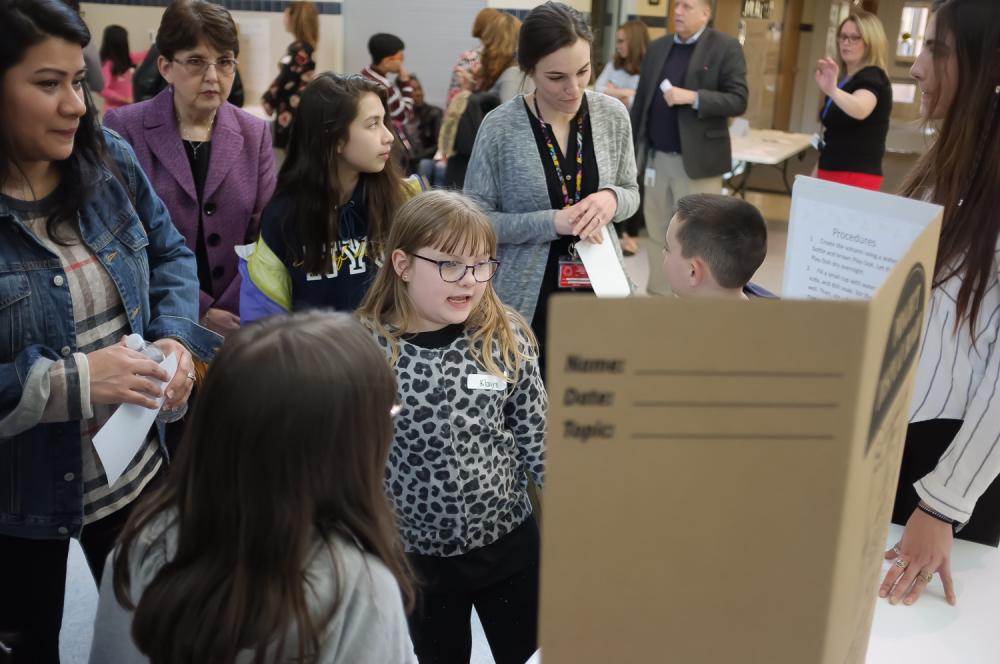It’s half an hour to showtime in the spacious, sun-filled atrium. Glance upward and you can’t miss the painted five-foot-tall black paw print and the inscription “Panther Pride” along the open staircase’s tallest yellow wall. Clustered around the lobby, 20 presenters are steeling their nerves as best they can: pacing, fidgeting, rehearsing. Pressure to perform aside, it’s a decidedly casual event, evidenced by several shoelaces that need tying.
Coach Jessica Zentz-Ridenour gives final instructions to the 20 budding scientists. Speak loudly and clearly. Practice standing straight and making eye contact. Don’t block a guest’s view of your poster. Plan for who in your group will talk about your hypothesis and who will discuss results.
The clock ticks to 4:30, and the lobby rapidly fills with parents, siblings, teachers, volunteers, and NCI staff members and scientists. Among the visitors is Theresa Alban, Ph.D., the superintendent of Frederick County Public Schools, who stops by each poster, asking questions and snapping pictures on her smartphone. The images filling her screen represent a range of scientific inquiries:
- Will sodium polyacrylate polymer (a powder used to make realistic-looking fake snow) act differently when hydrated with tap water versus seltzer water?
- What colors are combined to make black jellybeans, and is that combination the same in different brands of the candy?
- How did Revolutionary War combatants embed secret messages into paper?
- Does the size of an effervescent Alka-Seltzer tablet affect the rate at which it dissolves in water?
- In a scale model of a volcano, how do acids and bases react with one another?
Kids’ stuff, you might think. I did that “experiment” in elementary school. You would be correct, of course, but then again, this actually is an elementary school, and the very fact that these second, third, and fourth graders are participating and are so enthusiastic about their projects is an important stride—and the result of a new partnership with the NCI at Frederick.
Lincoln Elementary School is one of six elementary schools in Frederick County designated Title I, which means it qualifies for federal funding to assist students at risk of failure and living at or near the poverty level. Among Lincoln’s 583 students, 73 percent receive free or reduced-price meals. Just over a quarter are non-native English speakers.
The partnership with Lincoln, so new it doesn’t yet have a formal name, is the brainchild of Lea Jih-Vieira, a high school senior from the NCI at Frederick’s Werner H. Kirsten Student Intern Program. Jih-Vieira envisioned a way to help expose more elementary schoolers to scientific thinking and experimentation, perhaps also imparting a bug that will stick with them through a lifetime of learning. Administrators and staff members, including Zentz-Ridenour (a teacher specialist for student achievement and data analysis) and Sara Sloan (a first-grade teacher), from Lincoln embraced the idea, and Jih-Vieira recruited other Kirsten interns and members of the Science National Honor Society to be mentors in the after-school program. Colloquially known as “the science club,” the program is, says Cathleen Cullen, education outreach specialist for the NCI at Frederick, a prime example of “the power behind partnerships.” Cullen hopes it will be the first of a series.
The rewards are more than posters and presentations. “A program like this brings science expertise to these children. It can inspire interest in science, but it also then helps them be confident that they can go to a science fair, they can do a project,” said Alban, the superintendent. “I don’t know how you measure that, but when you listen to these young people talking, this is a big step for them that may not have been possible without this kind of mentoring and support.”
A sign of that big step: at least nine of the science club kids plan to take part in the upcoming county science fair. Last year, Lincoln had one student who participated.
Alban also spoke of the value of high school students as mentors. Children, she said, “will emulate people, and when they see these high school kids who they think are cool, who think science is cool, then that opens up a new possibility for them.” And the benefit for the high school volunteers? “These mentors now see the value of giving back.”
As the hour of poster-side presentations wraps up, each young scientist receives a certificate and a round of applause. There remains just one more job to be done before they head home, one that requires no scientific method: snacks.


